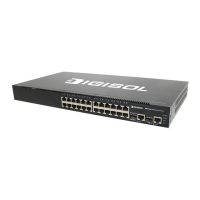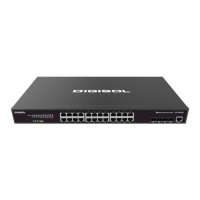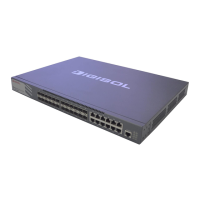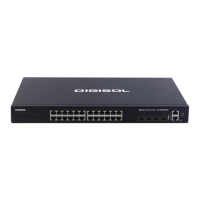Configuring the Switch
3-44
3
www.digisol.com
Configuring SNMPv3 Groups
An SNMPv3 group sets the access policy for its assigned users, restricting them to
specific read, write, and notify views. You can use the pre-defined default groups or
create new groups to map a set of SNMP users to SNMP views.
Command Attributes
• Group Name – The name of the SNMP group to which the user is assigned.
(Range: 1-32 characters)
• Model – The user security model; SNMP v1, v2c or v3.
• Level – The security level used for the group:
- noAuthNoPriv – There is no authentication or encryption used in SNMP
communications. (This is the default for SNMPv3.)
- AuthNoPriv – SNMP communications use authentication, but the data is not
encrypted (only available for the SNMPv3 security model).
- AuthPriv – SNMP communications use both authentication and encryption (only
available for the SNMPv3 security model).
• Read View – The configured view for read access. (Range: 1-64 characters)
• Write View – The configured view for write access. (Range: 1-64 characters)
• Notify View – The configured view for notifications. (Range: 1-64 characters)
Table 3-5 Supported Notification Messages
Object Label Object ID Description
RFC 1493 Traps
newRoot 1.3.6.1.2.1.17.0.1 The newRoot trap indicates that the sending
agent has become the new root of the Spanning
Tree; the trap is sent by a bridge soon after its
election as the new root, e.g., upon expiration of
the Topology Change Timer immediately
subsequent to its election.
topologyChange 1.3.6.1.2.1.17.0.2 A topologyChange trap is sent by a bridge when
any of its configured ports transitions from the
Learning state to the Forwarding state, or from
the Forwarding state to the Discarding state.
The trap is not sent if a newRoot trap is sent for
the same transition.
SNMPv2 Traps
coldStart 1.3.6.1.6.3.1.1.5.1 A coldStart trap signifies that the SNMPv2
entity, acting in an agent role, is reinitializing
itself and that its configuration may have been
altered.
warmStart 1.3.6.1.6.3.1.1.5.2 A warmStart trap signifies that the SNMPv2
entity, acting in an agent role, is reinitializing
itself such that its configuration is unaltered.

